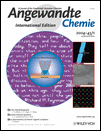Silica–Water Reaction Media: Its Application to the Formation and Ring Opening of Aziridines†
Satoshi Minakata Dr.
Department of Applied Chemistry, Graduate School of Engineering, Osaka University, Yamadaoka 2-1, Suita, Osaka 565-0871, Japan, Fax: (+81) 6-6879-7402
Search for more papers by this authorDaisuke Kano Dr.
Department of Applied Chemistry, Graduate School of Engineering, Osaka University, Yamadaoka 2-1, Suita, Osaka 565-0871, Japan, Fax: (+81) 6-6879-7402
Search for more papers by this authorYoji Oderaotoshi Dr.
Department of Applied Chemistry, Graduate School of Engineering, Osaka University, Yamadaoka 2-1, Suita, Osaka 565-0871, Japan, Fax: (+81) 6-6879-7402
Search for more papers by this authorMitsuo Komatsu Prof. Dr.
Department of Applied Chemistry, Graduate School of Engineering, Osaka University, Yamadaoka 2-1, Suita, Osaka 565-0871, Japan, Fax: (+81) 6-6879-7402
Search for more papers by this authorSatoshi Minakata Dr.
Department of Applied Chemistry, Graduate School of Engineering, Osaka University, Yamadaoka 2-1, Suita, Osaka 565-0871, Japan, Fax: (+81) 6-6879-7402
Search for more papers by this authorDaisuke Kano Dr.
Department of Applied Chemistry, Graduate School of Engineering, Osaka University, Yamadaoka 2-1, Suita, Osaka 565-0871, Japan, Fax: (+81) 6-6879-7402
Search for more papers by this authorYoji Oderaotoshi Dr.
Department of Applied Chemistry, Graduate School of Engineering, Osaka University, Yamadaoka 2-1, Suita, Osaka 565-0871, Japan, Fax: (+81) 6-6879-7402
Search for more papers by this authorMitsuo Komatsu Prof. Dr.
Department of Applied Chemistry, Graduate School of Engineering, Osaka University, Yamadaoka 2-1, Suita, Osaka 565-0871, Japan, Fax: (+81) 6-6879-7402
Search for more papers by this authorThis work was partially supported by a Grant-in Aid for Scientific Research from the Japan Society for the promotion of Science.
Graphical Abstract
Supporting Information
Supporting information for this article is available on the WWW under http://www.wiley-vch.de/contents/jc_2002/2004/z52842_s.pdf or from the author.
Please note: The publisher is not responsible for the content or functionality of any supporting information supplied by the authors. Any queries (other than missing content) should be directed to the corresponding author for the article.
References
- 1P. T. Anastas, T. C. Williamson in Green Chemistry, Designing Chemistry for the Environment (Eds.: ), American Chemical Society, Washington, DC, 1996, pp. 1–17.
- 2C.-J. Li, T.-H. Chan, Organic Reactions in Aqueous Media, Wiley, Chichester, 1997.
- 3
- 3aD. Tanner, Angew. Chem. 1994, 106, 625–646; Angew. Chem. Int. Ed. Engl. 1994, 33, 599–619;
- 3bW. H. Pearson, B. W. Lian, S. C. Bergmeie in Comprehensive Heterocyclic Chemistry II, Vol. 1A (Ed.: ) Pergamon, Oxford, 1996, pp. 1–60;
- 3cK. M. L. Rai, A. Hassner in Comprehensive Heterocyclic Chemistry II, Vol. 1A (Ed.: ) Pergamon, Oxford, 1996, pp. 61–96.
- 4Representative examples of direct aziridination of olefins, see
- 4aH. Kwart, A. A. Kahn, J. Am. Chem. Soc. 1967, 89, 1951–1953;
- 4bJ.-E. Bäckvall, J. Chem. Soc. Chem. Commun. 1977, 413–414;
- 4cJ. T. Groves, T. Takahashi, J. Am. Chem. Soc. 1983, 105, 2073–2074;
- 4dD. Mansuy, J.-P. Mahy, A. Dureault, G. Bedi, P. Battioni, J. Chem. Soc. Chem. Commun. 1984, 1161–1163;
- 4eR. S. Atkinson, B. J. Kelly, J. Chem. Soc. Chem. Commun. 1988, 624–625;
- 4fV. F. Rudchenko, S. M. Ignatov, R. G. Kostyanovsky, J. Chem. Soc. Chem. Commun. 1990, 261–262;
- 4gM. Barani, S. Fioravanti, M. A. Loreto, L. Pellacani, P. A. Tardella, Tetrahedron 1994, 50, 3829–3834;
- 4hD. A. Evans, M. M. Faul, M. T. Bilodeau, J. Am. Chem. Soc. 1994, 116, 2742–2753;
- 4iT. Ando, S. Minakata, I. Ryu, M. Komatsu, Tetrahedron Lett. 1998, 39, 309–312;
- 4jJ. U. Jeong, B. Tao, I. Sagasser, H. Henniges, K. B. Sharpless, J. Am. Chem. Soc. 1998, 120, 6844–6845;
- 4kT. Ando, D. Kano, S. Minakata, I. Ryu, M. Komatsu, Tetrahedron 1998, 54, 13 485–13 494;
- 4lD. Kano, S. Minakata, M. Komatsu, J. Chem. Soc. Perkin Trans. 1 2001, 3186–3188;
- 4mS. Minakata, D. Kano, R. Fukuoka, Y. Oderaotoshi, M. Komatsu, Heterocycles 2003, 60, 289–298.
- 5For reviews, see
- 5aI. W. C. E. Arends, R. A. Sheldon, M. Wallau, U. Schuchardt, Angew. Chem. 1997, 109, 1190–1211;
10.1002/ange.19971091104 Google ScholarAngew. Chem. Int. Ed. Engl. 1997, 36, 1144–1163;
- 5bB. Pugin, H.-U. Blaser in Comprehensive Asymmetric Catalysis, Vol. 3 (Eds.: ), Springer, Berlin, 1999, pp. 1367–1386;
10.1007/978-3-642-58571-5_16 Google Scholar
- 5cR. A. Sheldon, H. van Bekkum, Fine Chemicals Through Heterogeneous Catalysis, Wiley-VCH, Weinheim, 2001.
- 6Although quite recently a similar concept was revealed, it needs a complicated system including the requirement of a surfactant.R. Abu-Reziq, D. Avnir, J. Blum, Angew. Chem. 2002, 114, 4306–4308;
10.1002/1521-3757(20021104)114:21<4306::AID-ANGE4306>3.0.CO;2-G Google ScholarAngew. Chem. Int. Ed. 2002, 41, 4132–4134.10.1002/1521-3773(20021104)41:21<4132::AID-ANIE4132>3.0.CO;2-U CAS PubMed Web of Science® Google Scholar
- 7Silica gel 60 was purchased from Nacalai Tesque.
- 8For examples, See
- 8aK. R. Kloetstra, H. van Bekkum, J. Chem. Res. Synop. 1995, 26–27;
- 8bA. Cauvel, G. Renard, D. Brunel, J. Org. Chem. 1997, 62, 749–751;
- 8cF. Fajula, D. Brunel, Microporous Mesoporous Mater. 2000, 48, 119–125;
- 8dS. Jun, R. Ryoo, J. Catal. 2000, 195, 237–243;
- 8eV. R. Choudhary, S. K. Jana, N. S. Patil, Tetrahedron Lett. 2002, 43, 1105–1107;
- 8fJ. H. Clark, Acc. Chem. Res. 2002, 35, 791–797.
- 9
- 9aC. T. Kresge, M. E. Leonowicz, W. J. Roth, J. C. Vartuli, J. S. Beck, Nature 1992, 359, 710–712;
- 9bJ. S. Beck, J. C. Vartuli, W. J. Roth, M. E. Leonowicz, C. T. Kresge, K. D. Schmitt, C. T.-W. Chu, D. H. Olson, E. W. Sheppard, S. B. McCullen, J. B. Higgins, J. L. Schlenker, J. Am. Chem. Soc. 1992, 114, 10 834–10 843;
- 9cM. Grün, K. K. Unger, A. Matsumoto, K. Tsutsumi, Microporous Mesoporous Mater. 1999, 27, 207–216.
- 10Although substrates that have only an olefin moiety are adsorbed to the surface of silica in water by hydrophobic repulsion, the substrates with functional groups such as a hydroxy group have an ability to interact with the surface (terminal) of silica (HOSi), if they are not highly soluble in water.
- 11See Supporting Information.





